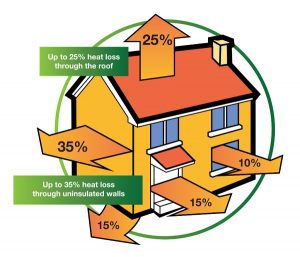To skip straight to registering your interest in having work done, just click here.
What is a Home Energy Upgrade?
This really could be a very technical answer but to keep things simple, it essentially involves insulation and draught proofing your house so that it is warmer, healthier and more comfortable for you to live in and with lower energy costs.
What is Retrofitting?
Retrofitting is the same as Home Energy Upgrades. Basically you are carrying out upgrade work on a house that has already been built, as opposed to adding these measures to a new build. In other EU countries the term used for retrofitting and home energy upgrades is ‘Renovation’.
What are the benefits to me and my family?
There are many benefits to carrying out energy upgrades on your home. They can be summed up with Comfort, Warmth, Health, Financial and Environmental.
How do I know if my home needs an upgrade?
 There are a number of indicators that your home needs an energy upgrade. Is your house cold and hard to heat? Are there draughts? Does the temperature vary a lot from room to room? Is your house an old house? These are just some of the questions you can ask yourself that you can answer easily. You can of course get a more accurate picture by getting a BER rating for your house (see below for more info.).
There are a number of indicators that your home needs an energy upgrade. Is your house cold and hard to heat? Are there draughts? Does the temperature vary a lot from room to room? Is your house an old house? These are just some of the questions you can ask yourself that you can answer easily. You can of course get a more accurate picture by getting a BER rating for your house (see below for more info.).
Regulations regarding insulation only came into force for houses being built from 2006 onwards. So if your house was built before 2006, chances are that it needs energy upgrade work. It may have insulation in the attic, but is it enough and in line with recommendations?
25% of heat loss is through the roof of poorly insulated attics. To put this into context, if you are spending say €2000 each year on home heating oil and don’t have adequate attic insulation, you are effectively wasting €500 each year. As the price of oil increases along with carbon tax, this wasted money will increase over time.
Why should I use Energy Communities Tipperary Cooperative (ECTC) to carry out works?
Carrying out work on your home can be quite stressful, especially when you are not sure what needs to be done or how it should be done, who will you get to do the work and what grants you are eligible for. Our professional project coordinators remove all the hassle for you. They look after grant applications, dealing with contractors and overseeing the whole project from start to finish.
ECTC has a long track record in providing retrofit services and energy upgrades to homeowners. Since 2012, ECTC has upgraded over 800 homes and secured over €10 million in investment for Tipperary, with funding from the Sustainable Energy Authority of Ireland (SEAI).
ECTC offers a complete One Stop Shop for home retrofits and has teamed up with Credit Unions throughout Tipperary who are happy to provide finance through Green Loans for home renovations (click here for more info).
How much will it cost?
This all depends on how much work is required and what your current BER rating is. As you can imagine, no two houses are the same. Our project coordinators will be able to advise you on what to expect and how much grant funding you will be eligible to receive once you provide some information about your house.
How much are the grants for home retrofits?
Currently everyone that qualifies is entitled to up 35% funding for carrying out home energy upgrades and retrofit work. Home owners in receipt of certain social welfare payments can qualify for up to 80% funding.
How do I begin the process?
The first step is simply filling in the details on this form to register your interest and our Project Coordinator will be in touch with you: https://energycommunitiestipp.ie/register/
What is a BER rating?
To get a more accurate idea of how energy efficient your house is, you can get a Building Energy Rating (BER) assessment. A BER certificate indicates your homes energy performance. It is similar to the energy label for household appliances. The certificate rates the energy performance of your home on a scale of A-G. A-rated homes are the most energy efficient and will tend to have the lowest energy bills. G-rated are the least energy efficient.
